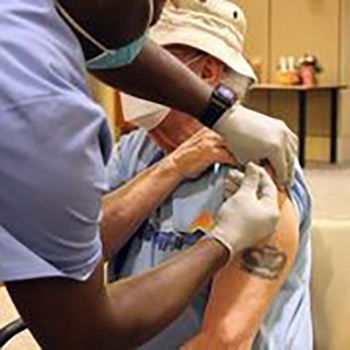 Armed Forces Retirement Home resident and WWII veteran Rafael Lopez, 93, prepares to receive one of the first COVID-19 vaccines administered at AFRH on Monday, December 21, 2020. (Photo by Carolyn Haug, Armed Forces Retirement Home.)
Armed Forces Retirement Home resident and WWII veteran Rafael Lopez, 93, prepares to receive one of the first COVID-19 vaccines administered at AFRH on Monday, December 21, 2020. (Photo by Carolyn Haug, Armed Forces Retirement Home.)
“All older adults are at greater risk for becoming critically ill if they are infected with SARS-CoV-2, which causes COVID-19. DOD is eager to reach out to this beneficiary population—including those not enrolled at an MTF—and let them know that it’s his or her turn if they so choose,” said Air Force Colonel Tonya Rans, Defense Health Agency’s Chief of the Immunization Healthcare Division. “Offering these safe and effective vaccines through DOD provides another option to those who may not yet have access through their civilian provider or pharmacy.”
There are currently two authorized COVID-19 vaccines in the United States, and each requires two doses to be fully effective. Risk for severe illness with COVID-19 increases with age, with older adults at highest risk, and adults 75 and older are at up to eight times higher risk of hospitalization from COVID-19 infection than younger, healthy adults. Further, all COVID-19 vaccines currently available in the United States have been shown to be highly effective at preventing the disease.
Additionally, second-dose reminders are critical to achieve optimal vaccine effectiveness. Arrangements for scheduling a second dose and setting a reminder can be made while you are getting your first dose. Importantly, vaccines are NOT interchangeable and a vaccine recipient’s second dose must be from the same manufacturer as the first dose.
A reminder to beneficiaries and other personnel: Getting vaccinated yourself may also protect people around you, particularly people at increased risk for severe illness from COVID-19. But even if you have been vaccinated, other COVID-19 safety precautions like masks, social distancing and frequent handwashing should remain in effect until experts better understand the extent of protection that COVID-19 vaccines provide.
Answers to frequently asked questions can be found on this TRICARE page; and at the CDC website. For more COVID-19 information check the Health.mil website. When misleading information circulates, vaccination coverage can fall and increase the risk for outbreaks.